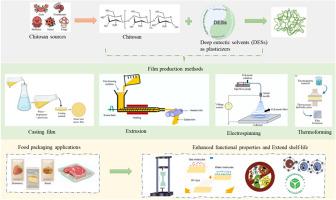Recent advances in the application of deep eutectic solvents (DESs) as plasticizers in the production of chitosan-based packaging films
IF 15.4
1区 农林科学
Q1 FOOD SCIENCE & TECHNOLOGY
引用次数: 0
Abstract
Background
The environmental drawbacks of the synthetic plastics and additives used in packaging occasioned the transition to sustainable and eco-friendly food packaging systems, which implies the use of biopolymers from renewable sources. Chitosan is a biopolymer derived from renewable sources, which provides promising materials for food packaging due to its biodegradable, bioactive, and functional properties. Nonetheless, chitosan-based films require the incorporation of plasticizers to improve their characteristics. Recently, the plasticizing effect of deep eutectic solvents (DESs) has been proved to be prominent and efficient. The introduction of DESs as plasticizers in chitosan-based packaging materials offers sustainable and green pathways for the development of packaging systems.
Scope and approach
This review explores the recent advances in the development of chitosan-based films, focusing on the use of DESs as plasticizers. We elucidated the production and characteristics of chitosan-based films and the plasticizer behavior of DESs. This review provides a global view of the factors affecting plasticizer properties of DESs for the formation of chitosan-based films. The application of DESs and chitosan-based films for food packaging has been outlined along with the challenges.
Key findings and conclusions
The most common procedure for producing chitosan-based films is casting. DESs have emerged as a new generation of green plasticizers due to their unique physicochemical characteristics and environmental advantages. The use of DESs as plasticizers in chitosan-based films improves the physical, mechanical and bioactive properties of the films, but their performance can be affected by their composition, molar ratio and amount added to the film solution. These findings highlight the potential of DESs for the plasticization of chitosan films as a novel technology in food packaging systems. The production processes of these films should be translated at an industrial level to maximize their potential.

深共晶溶剂作为增塑剂在壳聚糖基包装膜生产中的应用进展
包装中使用的合成塑料和添加剂的环境缺点促使向可持续和生态友好的食品包装系统过渡,这意味着使用可再生资源的生物聚合物。壳聚糖是一种从可再生资源中提取的生物聚合物,具有生物可降解、生物活性和功能性等特点,在食品包装领域具有广阔的应用前景。然而,壳聚糖基薄膜需要加入增塑剂来改善其特性。近年来,深共晶溶剂(DESs)的塑化效果已被证明是显著而有效的。在壳聚糖基包装材料中引入DESs作为增塑剂,为包装系统的发展提供了可持续和绿色的途径。本文综述了壳聚糖基薄膜的最新进展,重点介绍了壳聚糖作为增塑剂的应用。本文阐述了壳聚糖基薄膜的制备方法、特点以及DESs的增塑剂性能。本文综述了影响壳聚糖基薄膜形成的聚醚增塑剂性能的因素。概述了DESs和壳聚糖基薄膜在食品包装中的应用及其面临的挑战。主要发现和结论生产壳聚糖基薄膜最常见的程序是铸造。DESs以其独特的物理化学特性和环保优势,成为新一代绿色增塑剂。在壳聚糖基薄膜中使用DESs作为增塑剂可以改善薄膜的物理、机械和生物活性性能,但其性能会受到其组成、摩尔比和加入量的影响。这些发现突出了DESs作为食品包装系统中壳聚糖薄膜塑化新技术的潜力。这些电影的制作过程应在工业水平上进行翻译,以最大限度地发挥其潜力。
本文章由计算机程序翻译,如有差异,请以英文原文为准。
求助全文
约1分钟内获得全文
求助全文
来源期刊

Trends in Food Science & Technology
工程技术-食品科技
CiteScore
32.50
自引率
2.60%
发文量
322
审稿时长
37 days
期刊介绍:
Trends in Food Science & Technology is a prestigious international journal that specializes in peer-reviewed articles covering the latest advancements in technology, food science, and human nutrition. It serves as a bridge between specialized primary journals and general trade magazines, providing readable and scientifically rigorous reviews and commentaries on current research developments and their potential applications in the food industry.
Unlike traditional journals, Trends in Food Science & Technology does not publish original research papers. Instead, it focuses on critical and comprehensive reviews to offer valuable insights for professionals in the field. By bringing together cutting-edge research and industry applications, this journal plays a vital role in disseminating knowledge and facilitating advancements in the food science and technology sector.
 求助内容:
求助内容: 应助结果提醒方式:
应助结果提醒方式:


